AudioCulture
The noisy library of New Zealand music
Te pātaka korihi o ngā puoro o Aotearoa

Beatles invade New Zealand, 1964

Wellington greets The Beatles
In 1964, on a sunny Sunday afternoon in mid-winter, 7000 Wellingtonians made their way to Rongotai airport to greet four Liverpudlian musicians who combed their hair forward. The Beatles’ eight-day visit to New Zealand has been well covered in the 50 years since they first touched ground in Wellington, and memories are conflicting and keep getting adjusted, but questions still remain. Why, so early in their career, did the band get such a reaction in New Zealand? And what song was it that Paul McCartney worked on later that night while trapped in the St George Hotel?

Photo by Morrie Hill. National Library of New Zealand
We already had rock and roll stars of our own: first Johnny Devlin , and more recently Max Merritt and The Meteors, and Ray Columbus and The Invaders . And we had already received several visits by stars of the early rock and roll era: first Johnny Cash and Gene Vincent, then Johnnie Ray, and only a few weeks before The Beatles, a package tour featuring Gerry and the Pacemakers, Dusty Springfield, Gene Pitney, and Brian Poole and the Tremelos. This April 1964 tour – promoted by Harry M Miller – was billed as “the wild Liverpool Sound show”, though only the Pacemakers crossed the Mersey. None of these visits compared to the welcome given to Nat “King” Cole, who drew 5000 Aucklanders – most of them young women – to Whenuapai airport when he arrived for a concert in January 1955.

With large, plastic tiki and a giant kiwi, The Beatles arrive in Wellington
Tickets to the Beatles shows were priced from £1/9/6 to £2/10/6 ($60-$100 in 2013 dollars). A few months before the tour, Lew Pryme , a young Auckland reporter for Truth and an aspirant pop singer, went to the box office at the St James on Queen Street see the reaction when Beatles tickets went on sale. Unlike Australia, where Beatles fans had camped for two or three days, “We went down to get the story and low and behold, we were the first in the queue,” said Pryme. “The conditions were wet and cold, and soon there were something like three or four hundred fans behind us.”
Awareness of The Beatles changed quickly. From ‘Please Please Me’ on, all the group’s classic singles had been released in New Zealand on Parlophone through His Master’s Voice (NZ) Ltd, soon after going on sale in Britain. But in the weeks between the “Liverpool Sound” show and The Beatles’ tour, there was a deluge of extra releases. From late April through to June 1964, HMV released as New Zealand singles ‘Can’t Buy Me Love’ b/w ‘You Can’t Do That’ (from the film A Hard Day’s Night , which wouldn’t come out until July), and several other singles taken from early albums or EPs: ‘All My Loving’ b/w ‘Roll Over Beethoven’, ‘Twist and Shout’ b/w ‘Boys’, ‘Money’ b/w ‘Do You Want to Know a Secret’, and ‘Long Tall Sally’ b/w ‘I Call Your Name’.

Paul gets a hongi in Wellington
Even with very little radio air-time being devoted to current pop music, it is no wonder that New Zealand was well prepared for The Beatles’ visit. Perhaps HMV realised how its USA equivalent, Capitol, had dropped the ball in the year prior to the group’s pivotal appearance on The Ed Sullivan Show four months earlier. Undoubtedly HMV’s parent company in Britain, EMI, had more clout over its colonial subsidiary. Whatever, the New Zealand company had its publicity machine well-oiled. The influential entertainment magazine Playdate featured The Beatles on the cover in April (their tour was promoted by Kerridge-Odeon, which owned Playdate ). Also, footage of The Beatles’ arrival in Wellington shows many fans holding up copies of With The Beatles , their most recent album, and many other fans wave professionally produced placards of welcome.

Ringo is greeted in Wellington
As The Beatles stepped down from the propeller-driven TEAL Electra plane which had brought them from Sydney, someone thrust a giant fluffy kiwi into the hands of Paul McCartney, then all four Beatles were given large green tiki made out of thin, moulded plastic. Next came a Māori pōwhiri, for which women from the local Te Pataka Māori Group had been recruited. Ringo’s initial reaction to the Māori welcome was overheard by a nearby policeman: “Fook!” he said. “We come in peace!”

The Beatles arrive in Wellington
Each Beatle was given a hongi by the women. “I think it was Ringo Starr I picked out,” one of the youngest of the six women, Donas Nathan, told me in 1984. “Oh, it was quite an experience – I didn’t realised it was such a big thing until I got up there. The tikis were great big ones, and they were given to us by the Tourist and Publicity Department, I think.” McCartney received his hongi from “Aunty” Millie Clark. “She was like a kid too,” said Nathan, “and here we were – I was married at the time, with a child, and oh, I felt like a teenager! I just said to Ringo, ‘Kia ora and welcome to New Zealand’, and we pressed noses.”

Fans await the Fab Four in Wellington - Photo by Morrie Hill. National Library of New Zealand

The two big stories of the day ...
Still clutching their poi, and standing on the back of a slow-moving Holden ute, The Beatles were driven around the perimeter of the airport to greet the 7000 fans pressing against the chain-wire fence. Then they were driven into central Wellington – followed by a motorcade of fans in cars – to check into the St George Hotel on the corner of Willis and Boulcott Streets.

The Beatles on the balcony of the St George Hotel in on the corner of Willis and Boulcott Streets, Wellington - Photo by Morrie Hill. National Library of New Zealand
Crowds were already blocking the intersection, but the manager of the St George, Frank Drewitt, had been planning their arrival for months with Kerridge-Odeon, the Traffic Department and the Police. The crowd would eventually number 4000 as more fans arrived from the airport. Twenty policemen were at the front door to give the crowd the impression that was the way The Beatles would enter. But, said Drewitt, “I was waiting in the bottle store at the side of the hotel with about 12 policemen. On the pavement outside was a sergeant who, as The Beatles came down Willis Street, gave the signal: he lifted his hat and rubbed his forehead. I unlocked the door and the policemen stepped out as The Beatles’ car stopped at the kerb. The Beatles rushed out of the car like rats from a cage.”

The Beatles at their Wellington press conference - Photo by Morrie Hill. National Library of New Zealand
The group made their way to the third floor balcony to greet the fans, who were then told to disperse by an official with a loud-hailer: The Beatles weren’t going to be re-appearing. A frenzied press conference followed, attended by journalists such as Jim Hartley, female radio hosts Robin King and Doreen Kelso, and Johnny Douglas and Pete Sinclair of The Sunset Show , ZB’s hip, daily pop radio programme. Douglas got all The Beatles to record stings for the programme – “Hello New Zealand, this is Ringo” – and Sinclair ended up spending quite a bit of time in The Beatles’ company over the next couple of days, recording interviews for The Sunset Show and moonlighting for Australian radio.

Ringo Starr on stage at the Wellington Town Hall, 24 June 1964 - Photo by an Evening Post Staff photographer. National Library of New Zealand
One thing that helped open the door for Sinclair was his role in getting an acoustic guitar for Paul McCartney to use while stuck in his hotel room. In 1984 Sinclair recalled: “I managed to secure a Spanish guitar for Paul McCartney on the Sunday, which was no mean feat. I got the manager of Begg’s music store to open up his shop and get one out for him. He wanted to work on a composition – but I’m sorry to say I can’t remember what composition it was. But in any event I managed to get him a Spanish guitar and in return for that I was allowed to get a great deal of exclusive material. I hung around in The Beatles suite with all The Beatles all the time they were in Wellington.”
Sinclair was stretching the truth here. The person who actually got the guitar for McCartney was a radio programmer from the war generation. Ken Avery was a leading jazz saxophonist and novelty songwriter (‘Tea at Te Kuiti’), whose day job was at the NZBC. In his memoir Where are the Camels? Avery writes that Douglas called him at about 7pm on the Sunday night to ask where he could get a guitar for McCartney to use, as all The Beatles’ equipment was locked in the Town Hall. Avery, who was well connected among jazzers, called around his musician friends but none wanted to lend “their beautiful Gibsons” to a mere pop group. “I rang Johnny Douglas back with the bad news. He said it didn’t matter what sort of guitar it was – anything no matter how old or cheap would do. Paul was going to re-string it to a ‘left-hand-drive’ as it were and practice on it.”

The results of a radio competition in Wellington in 1964. Counting the results are Neville "Cham the Man" Chamberlain and Rocky Douche who would later own Marmalade Studios.
Avery remembered his neighbours in Karori, whose daughter Susan was learning the guitar. “So I asked if I could borrow this guitar to lend to The Beatles for a few days. The answer was a firm yes, if I could get the boys to sign her autograph book.” Accompanied by his own daughter – an 11-year-old Beatles fan – he drove to the St George with guitar and autograph books. “Crowds of people were hanging round hoping for a glimpse of The Beatles. I had this cheap guitar in one hand, daughter Jane in the other, and as we approached the hotel at about 7.30pm I got a few remarks thrown at me from the crowd like, ‘Where are you going Ringo?’”

John with his second cousins, the Parkers, from Levin - Photo by an Evening Post Staff photographer. National Library of New Zealand
Unfortunately Avery’s daughter’s hopes of meeting the group were dashed when Douglas suggested he just hand the guitar over to one of The Beatles’ minders. When Avery returned a couple of days later to get the guitar – just before the group was due to check out – he and Drewitt asked one of The Beatles’ managers for the instrument. “He eventually found the guitar in one of the rooms. He said ‘Here it is – thanks very much.’ I said ‘Could you ask the boys to sign the front woodwork of it as a souvenir for Susie … ?’ This they did behind locked doors. I got Jane’s autograph book signed for good measure, but never actually saw a Beatle at any time.” Avery said that Susan’s father was later offered “£200 for that £8 Beatle-signed guitar. I hope Susie’s still got it, and left it strung the wrong way round to prove that Paul really did play on it.”

Paul, John and George, Wellington Town Hall, 24 June, 1964 - Photo by an Evening Post Staff photographer. National Library of New Zealand
Drewitt was an old-school hotel manager. He was still the manager when I asked him about the visit 20 years later. He cautiously wrote out his memories: “During their stay, school girls tried climbing up the fire escapes after school. They’d get to the entrance of the suites but were put in the lift and were sent back to the ground floor.

An unfortunate incident at the hotel in Wellington
“The only unpleasant incident was when a girl who had booked herself into the hotel tried to persuade a security guard to let her into The Beatles’ room. When he said she had no chance, she threatened to cut her wrists. He didn’t think she was serious, but when he ignored her, she took out a razor blade and slashed her wrists. She rushed back to her room and bolted the door. But I noticed the window to her room was slightly open, so a policeman got out onto the fire escape, pushed it open and got inside. She was there with a towel wrapped around her wrist. We sent for an ambulance and she was taken to hospital.
“The Beatles were playing a big game, with big money at stake, so they couldn’t afford to put a foot out of step. We had no problems with them, but the support band [Sounds Incorporated], who never had anything to do with The Beatles, played up – they messed up their rooms, damaged furnishings, even slashed some mattresses.
“But The Beatles were happy: they stayed in their rooms, where they ate all their meals and made a lot of toll calls home.”

Fans at Wellington Town Hall - Photo by Morrie Hill. National Library of New Zealand
One who penetrated the inner circle was Dianne Cadwallader, reporter for the shortlived Count Down magazine (and later, manager of Mr. Lee Grant). She managed to convince press agent Derek Taylor to get an interview with the group by bowling up on the Monday morning. While talking with them, she heard screams of “We love you Beatles” drifting up from the fans’ vigil in Willis Street, six floors below. “I pulled back the curtain to glance out,” she wrote. “Ringo came over and quickly pulled me away. ‘Don’t do that,’ he said. ‘They’ll think we’ve got birds up ’ere, and want to come up too.’ He laughed a kind of lop-sided chuckle.” George then wandered by, dressed in “a striking pair of red and black Chinese-style pajamas.”

Fans! - Photo by an Evening Post Staff photographer. National Library of New Zealand
Another who got an interview was Victoria University psychology lecturer Tony Taylor, who wanted to examine “the general personality pattern of The Beatles fans and the specific clinical features of hysteria and of neuroticism that were attributed to them.” Taylor interviewed Lennon, and attended one of the concerts. Under his coat he had a small reel-to-reel tape recorder – which mostly picked up screams, his main interest – and he had a dozen psychology students around the hall taking notes on fans’ behavior. Later, he got the young composer and music lecturer Jenny McLeod to analyse the beats versus screams ratio on the tape. “She found a selection of Beatles tunes varies from 67 to 200 beats per minute, with a mean frequency of 135,” Taylor wrote in his memoir. The academic paper he published was called Beatlemania – the Adulation and Exuberance of Some Adolescents .

Drewitt’s wife Ayline acted as the group’s matron while they were in the hotel. After standing on the balcony with them, dressed in her fur coat, she attended to their needs. Each morning about 10.30am she used a special knock on their door, and asked them what they wanted for breakfast. “They were always in their pajamas and dressing gowns, they felt the cold; they had the central heating up to a temperature that you could hardly bear. They loved it, they’d just come from Hong Kong to Wellington.”
All Ringo wanted was eggs, boiled for two minutes. “And I want it roonny ,” he would insist. “The other boys used to have a good breakfast, cooked, and the rest of the day seemed to me to be spent putting toll calls back to their girlfriends in England.” John Lennon asked Ayline, a former hairdresser, to trim his hair; she also pressed their suits, and arranged a light pre-concert meal (“Apple pie, mince meat, steak”) and an après-gig supper (chicken, ham salad). “Then they’d perhaps have a few drinks, but very little. They weren’t drinkers, not in those days.”
After the first two shows on Monday night, there was a small gathering back in the hotel; The Beatles shared twin rooms, which also had lounges. Cadwallader, who attended the shows with Derek Taylor, wrote that when the other Beatles went to bed – Ringo in his pink pajamas – McCartney entertained those left at the small party with the acoustic guitar.

It gets a little out of control at the second Wellington show - Photo by an Evening Post Staff photographer. National Library of New Zealand
Ayline asked The Beatles if they wanted to meet any girls during their visit: would they like to have a little supper party? “They weren’t greatly interested in meeting any girls,” she recalled. “But they thought about it and said, ‘Yes, you ask some girls, providing that none of them talk to the press. Not that they did anything that the press couldn’t write about.” From her beauty salon contacts Ayline chose the girls “very carefully. I knew I had to choose nice girls, nice nice nice girls. Nicely dressed, clean, attractive and interesting. I took the girls up and we had a lovely evening. They sat on the floor and played their guitars, ate their food and they really relaxed. They had some drinks but no way were they excessive.”
While there is no evidence to suggest anything disreputable took place while The Beatles visited New Zealand, I did get the feeling that Drewitt and his wife had signed an old hoteliers’ pact that prevented them from saying anything controversial.
John Lennon interviewed in Wellington
Ringo Starr interviewed in Wellington
The biggest fuss came at the first Wellington concert, at 6pm on June 22: the group was angry that the Town Hall’s in-house PA was woefully inadequate and underpowered. Johnny Devlin, one of the support acts, spoke to the volume-hesitant Town Hall sound man, and offered to help improve the PA for the next day’s two concerts. He contacted Philips Industries and an alternative PA was hired. A roadie who helped set it up told me the replacement PA included several 100 watt amplifiers, a big Altec flare speaker and a couple of 15-inch speakers by the organ at the back of the hall, and a couple of columns of speakers on each side of the stage. When Devlin was asked what he wanted in return, he just said “a photo with The Beatles”. The group obliged.

Johnny Devlin with The Beatles
The police were unprepared for the frenzied reaction of the fans at the concerts. At first the constables sat in the front row, with their helmets underneath. They found this left them flat-footed when it came to the stage invasions that constantly took place. So for the second show they were seated in front of the stage, but facing the audience.
Everyone mentions the noise: the screams drowned out the music. “It was hysteria,” said Greg Cobb, who was 14 and later worked in the music industry. “You could only hear the opening of every song.” Another Wellingtonian, Barney Richards, said, “As soon as they came on stage it was one continual scream. I was fairly close to the stage and above this continual scream I could catch occasional snatches of songs. I heard a few bars of ‘I Want to Hold Your Hand’ and then nothing more, just this scream. You couldn’t hear the music, you could just see them mouthing the lyrics.”

The Beatles programme cover
The full programme at Auckland Library
The two songs mentioned most by the people who were at The Beatles’ New Zealand concerts are ‘Till There Was You’ – a gentle ballad from The Music Man musical, for which the crowd quietened down – and ‘Boys’, because it was Ringo’s show-stopping moment. “As soon as he started singing ‘Boys’, the place went into bedlam!” said Richards. “I saw the Stones, the Dave Clark Five, Freddie and the Dreamers, Roy Orbison, the Hollies, the Pretty Things, P J Proby – all the major groups of the day. But I never saw anything like The Beatles. At least you could hear those other artists, and appreciate the music. But the Rolling Stones never got a reception like this.”

John leaves Wellington - Photo by an Evening Post Staff photographer. National Library of New Zealand
When The Beatles flew into Whenuapai airport, west of Auckland, on Wednesday 23 June, only about 300 fans were there to greet them. They got just a glimpse of the band, as officialdom had decided to bring the plane to a stop in a maintenance area 400 metres away, then whisk them away in a limousine. In the city, 2000 fans were waiting outside the Royal International Hotel on Victoria Street. Trapped by the fans, The Beatles’ limo inched through the crowd towards the loading bay, pushed by tour managers Neil Aspinall, Mel Evans and Lloyd Ravenscroft. It was 20 minutes before the area could be cleared of fans and the group could get out of the car. They were angry at the lack of protection by the police, whose attitude was summed up by the Inspector of Police. He told a member of The Beatles’ entourage, “We didn’t want ’em here, and I don’t know why you brought ’em.”

Ringo and George on the NAC flight from Wellington to Auckland - Photo by Morrie Hill. National Library of New Zealand
Lennon said later, “It was a bit rough. I thought definitely a big clump of my hair had gone. I don’t mean just a bit. They’d put about three policemen on for 3000 or 4000 kids and they refused to put more on. ‘We’ve had all sorts over ’ere, we’ve seen them all,’ they said, and they had seen them all as we went crashing to the ground.” Angry, Lennon threatened he wouldn’t perform that night unless more police were on duty.

Auckland also provided a silly civic stoush when Mayor Dove Myer-Robinson wanted to give the band an official welcome; there had been one for the Vienna Boys Choir a week earlier, and the following week there would be another for pianist Arthur Rubenstein. The mayor’s council wasn’t keen, mainly at the cost of £60 to the ratepayers, but also because they didn’t approve of The Beatles. In particular, Rugby Union-stalwart Tom Pearce was dead against, but he could have been describing the behavior of the All Blacks and their fans when he said: “If we are going to pander to the hysteria, antics, adulation, rioting, screaming and roaring and all the things these bewigged musicians engender, then I think we should make a point of honouring any youths with sporting backgrounds who are at least trying to get in the best traditions of the young men of this nation.”

The Beatles at Auckland Town Hall
In the end the impasse was solved when it was decided that a civic welcome was appropriate, but not a civic reception. The Mayor would wear his chains of office, but not his robes. Another establishment body that disapproved of The Beatles’ visit was the Auckland Education Board, whose officials took the names of school-age fans who attended the welcome outside the Town Hall, and said they were going to prosecute their parents.

Excerpt from the minutes of the Auckland City Council protesting The Beatles reception
The Beatles arrived late. The police had declined to provide an escort for the short journey from the Royal International to the Town Hall. The chief constable, Superintendent Quinn, said, “We provide such escorts only for royalty and other important visitors.”
The crowd was estimated at 7000, and the only negative notes came from those who carried an effigy of Tom Pearce, and the flat singing of the mayor, who called for the crowd to sing ‘Now is the Hour’ but ended up doing it alone. The Beatles attended for 25 minutes, and ended up standing on their chairs so they could be seen. “The Māori singers and dancers were great,” George Harrison said afterwards. “I liked the pois.” Lennon responded, “Pois? Isn’t that what Ringo sings?”

The Beatles at their Auckland reception, applauding Māori performers - Simon Grigg collection
At the concert, it was mayhem again. As was usual for the time, the show had a packaged, variety-style format. Comedian Allan Field acted as compere, warming up the crowd then introducing Johnny Devlin. Australian singer Johnny Chester followed – both singers were backed by well-groomed Melbourne group The Phantoms – and then, horn-based instrumental group Sounds Incorporated.

The Beatles with the Mayor of Auckland, Dove-Myer Robinson - Simon Grigg collection
Finally, The Beatles came on, playing between 26 and 28 minutes a night, rattling through a set-list that on this tour was usually ‘I Want to Hold Your Hand’, ‘I Saw Her Standing There’, ‘You Can’t Do That’, ‘All My Loving’, ‘I Wanna Be Your Man’, ‘She Loves You’, ‘Till There Was You’, ‘Roll Over Beethoven’, ‘Can’t Buy Me Love’, ‘This Boy’ and finally ‘Long Tall Sally’. (Most fans I have talked to who attended one of the concerts mention Ringo singing ‘Boys’, although this doesn’t tally with set-lists. Perhaps they are confusing it with ‘I Wanna Be Your Man’, which he sang, but it is never mentioned, neither is the slow three-part harmony ballad ‘This Boy’. But as Derek Taylor once told me on questions of Beatles accuracy, “I always trust the fans.”)

The Beatles in the Auckland Town Hall - Richard Morris collection
Lew Pryme recalled, “It was the first time I’d ever been exposed to the mania and fanaticism of a screaming teenage audience.” Broadcaster Barry Holland said, “When The Beatles came on stage there was scream after scream, and I’d never experienced anything like this even though I was a teenager myself. We’d heard about it, but this was absolutely fantastic. The atmosphere was electric in there when John Lennon first got up to sing at the microphone.” Booking agent Benny Levin told me he “vividly remembered the concerts” but he came out with “the most shattering headache I’ve ever had in my life.” The screams didn’t just come from teenage fans, said Levin: “I would say they also came from a lot of middle-aged ladies that were there as well. It was hysteria with the young girls at that show, and they were fainting all over the place. The St John Ambulance men were dragging them out like you wouldn’t believe.”

The crowd at the City Hotel, Dunedin. The arrow points to the band.
On Thursday 25 June, The Beatles flew to Dunedin. Their plane was 30 minutes late because a phone call had been received in Auckland saying there would be a “germ bomb” on board. Suspecting it was a prank from a member of the tour entourage, an Auckland police inspector reportedly locked the bands’ stage gear up for the night at their headquarters, and his men searched through the personal luggage of the party.
The incident that dominated The Beatles’ visit to Dunedin occurred when they arrived at the City Hotel. The police were unprepared for the hysteria among the 2000 people outside, who crowded the entrance and climbed onto the verandah above. The police took 10 minutes to form a gap in the crowd, and were jostled as they escorted the band. John Lennon was the last out of the car and by this time the police and security men had had enough. Dunedin broadcaster Neil Collins remembers the police picking up Lennon and throwing him through the front door. “I mean that. He was airborne when he reached that lift, and he was wearing leather pants and he cut his knee open on the iron of the lift.” Lennon stormed up to his room on the third floor, and refused to attend the press conference.

"Germ" bomb threats on the flight to Dunedin
That night, Collins was asked to be a decoy while The Beatles were sneaked into the Town Hall. With him was Russell Clark (later a business partner of Benny Levin and Craig Scott), Max Merritt and one of his Meteors. “The promoter said, ‘If you do this for us you’ll get to meet them later for supper. Turn your collar up, comb your hair forward, put your head down and race through the crowd to the limousine. It’s as simple as that, lads.’ We all thought it was great fun, so we did it, but as we did the crowd surged forward and there were people yanking and pulling at our hair. At that moment I wondered why I’d said yes, because it was quite terrifying.
“Before the car could move off the noise inside was deafening, with everybody bashing on the outside, and there was lipstick smeared all over the car. So off we went, and I can still see two old ladies outside Hallensteins waving frantically, so of course we got right into the act and waved back.
“Meanwhile The Beatles scurried out the back entrance of the hotel amongst trash cans and rubbish and got into a little Ford. They went around to the bottom end of Moray Place and came in the side entrance. They were in and out before anyone ever knew.”
Collins said to Paul McCartney: “I can’t believe you go through that performance every time you get out of a car to arrive at a hotel or concert. You must be battered and bruised all day. And he said, ‘Look we told your bobbies here, you’re going to have crowds and pushing and shoving. They said to us, ‘Don’t tell us about crowd control – we’ve had Vera Lynn through here twice’.”
Wayne Mowat, a Dunedin teenager and aspirant musician who later became a long-serving RNZ broadcaster, went to the 8pm show. “When we arrived I remember all the school girls and their mates were in raptures about the first show. Some of the girls were almost hysterical. That was the effect The Beatles had.
“We were about the eighth row from the front, and we were all quite well-built schoolboys and when The Beatles came on, we were suddenly at the back. There was a rush forward as soon as The Beatles came on in their mop tops and McCartney and Lennon started shaking their heads. That’s when hysteria really took over. The show up till then had been pretty sedate. They had Johnny Devlin on first and a comedian who introduced The Beatles but he was drowned out. After the concert everybody streamed down to the City Hotel and chanted out ‘We want The Beatles, we want The Beatles!’ Finally they did come out onto one of the balconies, just like royalty used to do.
“You could just hear the music. The crowd sat and listened to Paul McCartney sing ‘Till There Was You’’, one of the only soft slow numbers they did. The rest was just – loud. You couldn’t hear every note, but you knew it was The Beatles. No doubt about it.
Paul McCartney and John Lennon interviewed flying from Auckland to Australia
George Harrison and Ringo Starr interviewed flying from Auckland to Australia
“There was this young girl near us and she had a knitted hat with ringo on it and she threw it up on the stage. John Lennon flicked it up and threw it to Ringo and he caught it on his drumstick and popped it on his head. And this girl fainted . I’ll never forget that. She just passed out, she was rapt, it was all just too much. Here was Ringo with her hat on his head.”
Show over, The Beatles left the stage and – driven by a traffic cop with siren screaming – they were back in their hotel within three minutes.
"But we don't get blind or touch the drugs .." from NZ Truth, 30 June, 1964
Warned by the chaos that had occurred elsewhere in the country, the Christchurch police were better prepared. When The Beatles left Dunedin, the police took them on a route to the airport that was different to one published in the paper. In charge in Christchurch was George Twentyman, a police inspector later prominent during the Springbok tour. “We had a very flexible plan, but mainly to try and keep a distance between The Beatles and the young people,” he said. “Knowing they would go quite rampant if they were exposed too much to The Beatles, there had to be always quite a considerable space between The Beatles and the people, otherwise you’d have serious problems.” When The Beatles’ plane arrived in Christchurch, it was surrounded by police. A car at the bottom of the plane’s stairs whisked the group away while a crowd of 5000 watched at a distance.

The Beatles in Christchurch
The Beatles stayed at the Clarendon in central Christchurch, a grand old hotel where the Queen used to stay. Once again, female fans used the usual tactics to get inside to meet them, such as hiding in laundry baskets, but the mania was such that as The Beatles’ car got near the hotel, a 13-year-old girl lunged at the vehicle and was knocked down. She was taken inside the hotel and, for her trouble, got to meet The Beatles.
Twentyman described the female fans’ reaction to me. “Hysterical’s not the word, because when they’re hysterical they start crying. They were transported, I’d say, into ecstasy and excitement. Yet the boys, you could see it, they were trying to look as if they were, but they weren’t. The girls were screaming their heads off and carrying on. The girls just lost themselves.”
What made Christchurch different was a group of antagonistic males who stalked the band. Annoyed at all the attention The Beatles were getting from their Canterbury maidens, they threw a barrage of eggs at the hotel. A student also held up a placard that read: “We like Elvis, Cliff, Castro and Mao Tse-Tung but not The Beatles.”
The two concerts at the Majestic Theatre were once again reviewed for their novelty rather than their music. ‘Till There Was You’ was the only song one newspaper reviewer mentioned, preferring melodramatic reportage such as “… the shock waves reached danger level. The shrieking guitars, amplified through some fiendish electronic system, led the assault with Ringo’s drums filling in the gaps between blasts. The half-crazed audience did its best to scream and whistle above it all.” Some of the disgruntled boyfriends must have bought tickets, because among the usual jelly beans thrown at The Beatles, there were also marbles.
So it is understandable that The Beatles spent their last day in New Zealand in their Christchurch hotel rooms. When they left for the airport, the police – finally wise, but also a little mean-spirited – lined up outside the front door, where four cars waited. One limousine had its back door open, with a driver inside. It was another decoy: as 2000 fans gathered at the front door for The Beatles to appear, the police took the group out through a back entrance to another car.
At the airport that evening, another 2000 fans waited in the dark to bid them farewell. The runway had a brilliant, eerie glow thanks to the mercury vapour lamps used to light workers loading cargo for the Deep Freeze programme in Antarctica. A TEAL Electra taxied out; the distance from the public viewing platform and high wire fences to the plane was quite substantial, but still the police felt under pressure. Fifteen minutes before departure, The Beatles were driven onto the tarmac, and a boy ran towards the plane only to be grabbed by the police. The Beatles stood briefly on the plane’s steps for photographs and a wave, then boarded the plane to Sydney.
The Beatles’ only visit to New Zealand was almost over. As the Electra’s propellers warmed up, and the pilot was about to nudge the throttle, a policeman was heard to say, “If that bloody plane doesn’t go in the next few minutes, I’ll push it off myself.”
Read: The Beatles and New Zealand Music
Read: the story behind the large tiki given to the Beatles
Visit our sister site
Made with funding from
Follow us on social media
Partners with
The Beatles live: Town Hall, Wellington, New Zealand
The Beatles gave just four nights of concerts in New Zealand, starting on 22 June 1964. The trip was largely seen as less successful than previous stops on their world tour, mainly due to sound problems and police attitudes.
They performed at the Town Hall on Wellington’s Cuba Street. As on the following night, there were two shows, each of which was seen by 2,500 fans.
Prior to the concert The Beatles travelled from the Hotel St George in Auckland, without their usual police escort. The Auckland Chief Constable, Superintendent Quinn, refused, saying: “We provide such escorts only for royalty and other important visitors.”
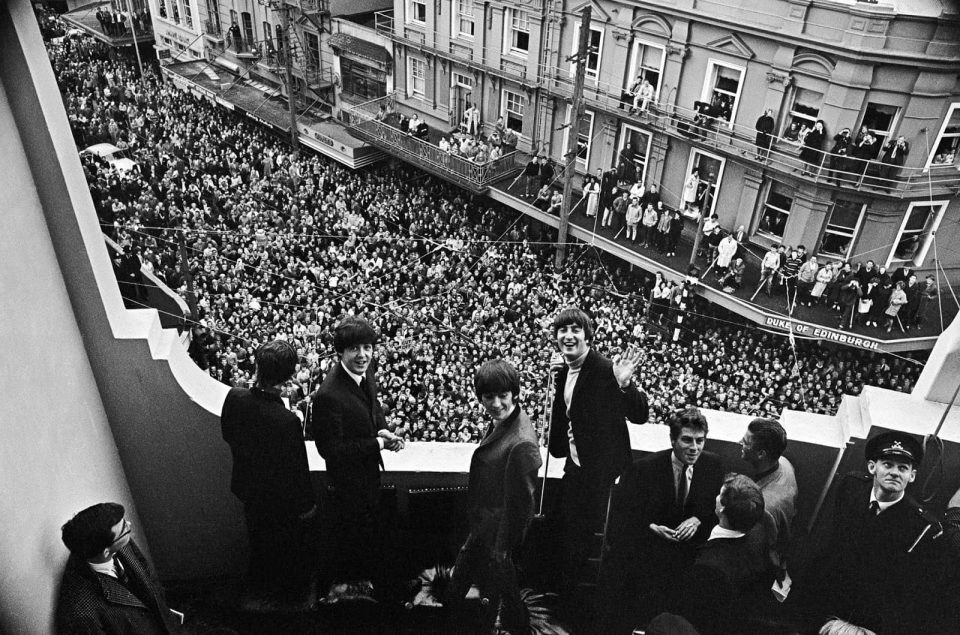
The first concert was likewise somewhat less than successful. The sound operator at the Town Hall had limited experience of rock ‘n’ roll shows, and was worried about the effects of turning up the speaker system. As the group came off stage an exasperated John Lennon shouted “What the fucking hell is going on here?”
The second set was louder, but the lack of a sound check meant the sound quality was still poor. However, one positive aspect of the night was that Ringo Starr ’s throat was sufficiently better for him to sing ‘Boys’ during both concerts.
We have sung through worse mics, but not very often; usually during the early days. We expected better here.
Wellington police were underprepared after the concert, having allocated just two officers to control a crowd of 5,000. The Beatles’ road manager Mal Evans was forced to leave the car and clear a path through the crowd.
The most notable thing that happened in New Zealand, although it wasn’t very good, was that the drummer from Sounds Incorporated had a girl in his room who tried to slash her wrists whilst he was out at the pub. I remember Derek panicking as the story was immediately on the wire service all over the world: ‘Suicide Attempt in Beatle Hotel’.
Also on this day...
- 2019: Paul McCartney live: Petco Park, San Diego
- 2014: Ringo Starr live: Durham Performing Arts Center, Durham, North Carolina
- 2013: Paul McCartney live: Stadion Narodowy, Warsaw
- 2012: Ringo Starr and his All-Starr Band live: Jones Beach Theatre, Wantagh
- 1995: Ringo Starr and his All-Starr Band live: Century Hall, Nagoya
- 1992: Ringo Starr and his All-Starr Band live: Great Woods Centre for the Performing Arts, Mansfield
- 1976: Wings live: Forum, Inglewood
- 1973: UK album release: Living In The Material World by George Harrison
- 1968: Paul McCartney addresses Capitol Records conference
- 1968: The Beatles purchase Apple headquarters at 3 Savile Row, London
- 1966: Mixing: Eleanor Rigby, She Said She Said, Good Day Sunshine, Yellow Submarine, Tomorrow Never Knows, Got To Get You Into My Life
- 1965: The Beatles live: Palais d’Hiver, Lyon, France
- 1964: Mixing, editing: A Hard Day’s Night album, Long Tall Sally EP songs
- 1963: The Beatles live: Town Hall, Abergavenny
- 1963: Television: Juke Box Jury
- 1962: The Beatles live: Cavern Club, Liverpool (evening)
- 1962: The Beatles live: Cavern Club, Liverpool (lunchtime)
- 1961: The Beatles live: Top Ten Club, Hamburg
- 1961: Recording: My Bonnie, The Saints, Why, Cry For A Shadow
- 1957: The Quarrymen live: Rosebery St, Liverpool
Want more? Visit the Beatles history section .
Leave a Reply
How 'Beatlemania' struck New Zealand on the band's 1964 tour
The Beatles were swarmed by crazed fans as they performed across the country.
The year is 1964, and at the peak of their fame, the Beatles visited New Zealand, where they were met with an all-too-familiar phenomenon — Beatlemania.
The iconic British boyband washed up on our shores to waves of screaming, adoring fans.
No one could anticipate the chaos the 'fab four' would bring to Aotearoa's streets as fans flocked, desperate to catch a glimpse of the Beatles. Many in the older generation were alarmed and even taken aback as they witnessed the devotees' outrageous reactions to the group.
The Beatles touched down at Wellington Airport on June 21, 1964 to the sight of 7000 crazed fans, each clawing to get as close as possible.
The group were officially welcomed with a traditional Māori hongi — a gesture the boys were evidently unfamiliar with — as well as Hei Tiki pendants.

Their fan frenzy welcome was a sign of what would come over the next seven days as chaos clung to the band. The Beatles played shows in Auckland, Wellington, Christchurch and Dunedin. They were touring their debut studio album; Please Please Me, and performed a 30-minute, 11-song set.
The main goal for many concert attendees was to get as close to the stage as possible, rather than enjoy the music. Audience members recall being unable to hear any of the songs as the crowd's screams were more powerful. It was pandemonium and the streets surrounding anywhere the Beatles ventured, were even more chaotic.
Auckland City Mayor Dove-Myer Robinson held a civic reception in the city, where a haka was performed for the Liverpool lads.
The mayor attempted to calm the crowd of hysterical fans but his pleas were simply met with more screams.
The crowds provided a lot of trouble for the Beatles, who were mobbed wherever they went. The group were not provided adequate security which led to egging, trampling, and even mauling by "devoted" fans.
Drummer Ringo Starr was hurt and John Lennon, one of the band's lead singers, lost a clump of hair when he got caught in the crowd's crossfire.
The rest of the shows were almost cancelled as a result.

Sixty years after Beatlemania's onset and with two of the quartet now dead, artificial intelligence has enabled the release of what is promised to be the last "new" Beatles song.
The track, called Now And Then, was released as part of a single paired with Love Me Do, the very first Beatles single that came out in 1962 in England, and will likely bring up memories of those who attended arguably one of the most memorable music tours in Aotearoa's history.
'From the Archive' is a weekly video series on 1News.co.nz, exploring TVNZ's vast records of news content spanning decades.
This story is from the New Zealand Television Archive.
More Stories

Splore festival to take 2025 off after 'challenging' season
The high-content festival was not able to break even in 2024, but organisers says it will return in February 2026.

Rapper J.Cole admits regret over Kendrick Lamar diss
Its the latest beef in a series of lyrical barbs fired between three of hip hops biggest stars - Drake, Kendrick Lamar and J.Cole.

Billie Eilish announces third album and reveals title, artwork

Country star arrested after throwing chair from Nashville bar roof

Rita Ora debuts costume for Descendants: The Rise of Red

ABBA fans celebrate 50 years since Waterloo took the world by storm
Vietnam real estate tycoon sentenced to death for $20.8b fraud
Downpour 2024: Almost 100 Air NZ flights cancelled in wild weather
Gold rush as price hits all-time high — is it time to cash in?
Russian soldiers have nowhere to go as thousands flee the war
Calls for trail changes after mountain biker's death
Video shows Canterbury rail bridge sagging after pillar washed away
28 mins ago
Two Australian cryptocurrency companies collapse owing $160m

Iguana and tortoise returned to reptile park following burglary

NSW celebrity lawyer raked over coals for sexual harassment

Fast-track approvals: Letter states some 'were invited' to apply

'Lack of care' bus driver jailed for Bondi crash death

Pedestrian in serious condition after Katikati crash on SH2

More from Entertainment

Prince Harry, Meghan Markle to produce two new Netflix shows
The shows are part of a multi-year deal between Netflix and Archwell Productions.

Warner Bros teases Joker sequel, Beetlejuice 2 and more at CinemaCon
Wed, Apr 10

Jon Snow Game of Thrones sequel not happening, Kit Harington says

Robert Downey Jr would 'happily' play Iron Man again

Bluey house 'listed for sale' in Brisbane
Beatles arrive in NZ, June 1964
A DigitalNZ Story by Zokoroa
Memories of the Beatles arriving in NZ on 21 June 1964 for an 8-day tour with 12 concerts in Wellington, Auckland, Dunedin and Christchurch.
Beatles , Music , Pop culture , Bands , Concerts , Beatlemania , John Lennon , Paul McCartney , George Harrison , Ringo Starr
The Beatles arrived in New Zealand on Sunday 21 June 1964 for an eight-day visit after touring Denmark, the Netherlands, Hong Kong and Australia.
Titles of songs from their first four albums are used to illustrate the Fab Four's experiences in NZ, as recounted by those who met the band and/or went to one of their twelve shows held in Wellington, Auckland, Dunedin, and Christchurch.
>>>>>>>>>>>>>>>>>
1. "Eight days a week " in NZ: 21 - 28 June 1964
Fans flocked to see and hear the "Fab Four" musicians from Liverpool - John Lennon, George Harrison, Paul McCartney and Ringo Starr - during their eight-day tour of New Zealand. The Beatles had become popular overseas and in NZ following the release of their first two albums "Please Please Me" (March 1963) and "With the Beatles" (November 1963). Both albums and singles had been released in New Zealand on Parlophone through His Master’s Voice (NZ) Ltd. The Beatles had also appeared on the British music programme, "Top of the Pops" produced by the BBC, which was shown in NZ. In November 1963, the British press coined a phrase for the frenzied fans: Beatlemania.
On Sunday 21 June 1964, the Beatles arrived in Wellington for an eight-day tour
John, George, Paul & Ringo were greeted with a Māori pōwhiri by six women from the local Te Pataka Concert Party
Alexander Turnbull Library
Te Pataka Concert Party performed a haka, before greeting each Beatle with a hongi
NZ was the next stop on their Australasia tour. They arrived from Sydney aboard a TEAL Electra plane.
The Beatles were also given a large tiki and poi
Ringo nicknamed his tiki 'Fred'. The green tikis were made of moulded plastic.
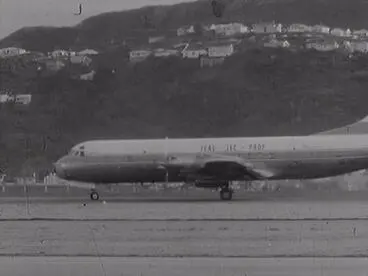
This silent film shows a large stuffed kiwi being given to John & each Beatle being welcomed as they left the plane
Accompanying them were their tour managers, Neil Aspinall, Mel Evans & Lloyd Ravenscroft
Manatū Taonga, the Ministry for Culture and Heritage
The Beatles were greeted by 7000 fans at the airport who were kept behind a wire fence with 30 police on guard
Wearing their tikis and waving their poi, the Beatles stood on the back of a slow-moving Holden ute past the fans
Find out more:
For an account of behind-the-scenes planning by airline traffic supervisor Peter Andrews, see: NZHerald (23 June 2014), " It was 50 years ago: Beatles in NZ, day by day ".
To find out what happened to John Lennon's tiki and information about the Te Pataka Concert Party, see: Charlie Gates, "Beatles tiki tour – How John Lennon's plastic tiki became a Kiwi family heirloom" (19 Jan 2019), URL: https://www.stuff.co.nz/national/109543613/beatles-tiki-tour--how-john-lennons-plastic-tiki-became-a-kiwi-family-heirloom
See film of the Beatles standing on the ute and waving at the fans: British Pathé : The Beatles Arrive In New Zealand 1964 (Length 2:13)
You can also listen to this audio account of the Beatles arriving in NZ: RNZ: "The Beatles New Zealand Tour 1964 Part 1: The Arrival, URL: https://www.rnz.co.nz/national/programmes/afternoons/audio/2600011/the-beatles-new-zealand-tour-1964-part-1
2. "There's a place" : Stayed at St. George Hotel
The Beatles stayed at the St George Hotel on the corner of Willis & Boulcott Streets
Organisers arranged for the Beatles to enter through the Hotel's bottle store to avoid the crowd at the front entrance
Beatlemania fans had been waiting holding welcome signs
The crowd increased in number to 4000 as more arrived from the airport
Ngā Taonga Sound & Vision
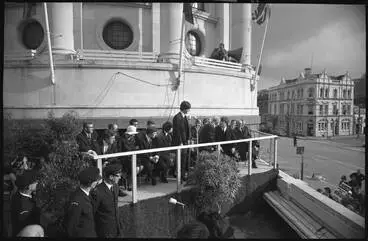
The Beatles appeared on the third-floor balcony to wave at the fans
Auckland Libraries
"Please Please Me": Paul borrows a guitar
For reminiscences about the Beatles staying at the St. George Hotel, including Paul McCartney borrowing a guitar to use in his hotel room as the band's gear had been taken to the Wellington Town Hall, see: Audioculture: Chris Bourke, 'Beatles invade New Zealand, 1964": URL: https://www.audioculture.co.nz/articles/beatles-invade-new-zealand-1964
"You can't do that" : Schoolgirls scaling fire escapes & bomb scares
Manager of the St George Hotel, Frank Drewitt, has shared memories of the Beatles' stay, including schoolgirls trying to reach the Beatles' floor by climbing up fire escapes. Newspapers also reported that police had received telephone calls that bomb attacks would be made on the St. George Hotel and the Wellington Town Hall. (See Audioculture, ibid )
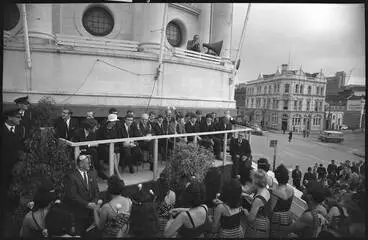
Schoolgirls would climb up the fire escapes to the entrance of the suites but were placed in a lift back to ground floor
Civic Reception for The Beatles, 1964
"boys" : press conference.
The press conference at the hotel included TV & radio presenter Pete Sinclair (standing on right with tape recorder)
Press included journalist Jim Hartley, radio hosts Robin King & Doreen Kelso, & Jonny Douglas (ZB's The Sunset Show)
Press pass for 4.30pm on Sun 21 June on St George Hotel's First Floor

Broadcasters Pete Sinclair & Doreen Kelso recall Beatlemania in 2009
Radio New Zealand

Jonny Douglas reminiscences how he & Pete Sinclair recorded interviews for ZB's pop radio programme 'The Sunset Show'
"do you want to know a secret ": interviews with john & ringo.
You can listen to:
'John Lennon interview in New Zealand, 1964' , URL: https://nzhistory.govt.nz/media/sound/john-lennon-in-new-zealand-interview-1964 , (Ministry for Culture and Heritage), updated 8-Jan-2015
'Ringo Starr interview in New Zealand, 1964 ', URL: https://nzhistory.govt.nz/media/sound/ringo-starr-in-new-zealand-interview-1964 , (Ministry for Culture and Heritage), updated 8-Mar-2013
Newspapers reported the arrival of the Beatles
"all i've got to do" : lead up to the concerts.
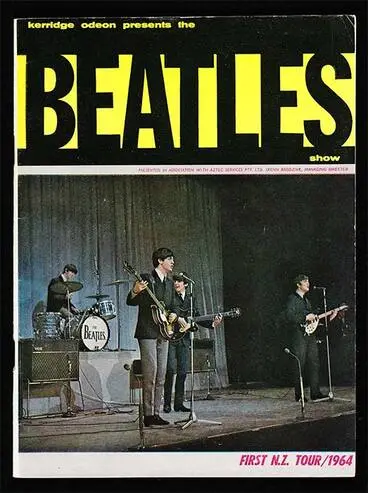
Kerridge Odeon & Harry M. Miller promoted the Beatle concerts
Kerridge Odeon also featured the Beatles on the cover of the April issue of its magazine 'Playdate'
"Can't buy me love" : Additional singles released by HMV
Additional songs were released as singles by HMV (His Masters Voice) in NZ:
"From late April through to June 1964, HMV released as New Zealand singles ‘Can’t Buy Me Love’ b/w ‘You Can’t Do That’ (from the film A Hard Day’s Night, which wouldn’t come out until July), and several other singles taken from early albums or EPs: ‘All My Loving’ b/w ‘Roll Over Beethoven’, ‘Twist and Shout’ b/w ‘Boys’, ‘Money’ b/w ‘Do You Want to Know a Secret’, and ‘Long Tall Sally’ b/w ‘I Call Your Name’."
Source: Audioculture: Chris Bourke, 'Beatles invade New Zealand, 1964": URL: https://www.audioculture.co.nz/articles/beatles-invade-new-zealand-1964
From late April to June, additional songs were released as singles by HMV in NZ
Songs were taken from albums and EPs
His Masters Voice New Zealand Ltd had a factory at Wakefield St, Wellington
Beatles publications were also advertised for 1/2 price by a bookseller
Tauranga City Libraries
3. "Twist and Shout" : Wellington concerts, 22 - 23 June
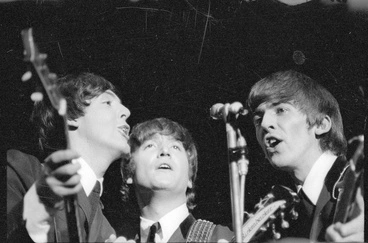
22 June: First two evening concerts held at Wellington Town Hall, 6pm & 8.30pm
Tickets were priced from £1/9/6 to £2/10/6
"I wanna be your man" : Show began with three supporting acts
See Youtube video: An interview with Johnny Devlin for his reflections on touring with the Beatles.
Opening acts: Johnny Devlin, Australian singer Johnny Chester (both backed by The Phantoms), & Sounds Instrumental group
Support act Johnny Devlin also toured with the Beatles in Australia
AudioCulture
"It won't be long" : Beatles play setlist of 11 songs over c.30 mins
The Beatles followed the 3 support acts and played a c.30 minute concert with a setlist of 11 songs
The Beatles performed the same 11-song setlist at every show - I Saw Her Standing There, I Want to Hold Your Hand, You Can't Do That, Till There Was You, All My Loving, She Loves You, Roll Over Beethoven, Can't Buy Me Love, This Boy, Long Tall Sally and Twist and Shout. Ringo Starr also sang Boys.
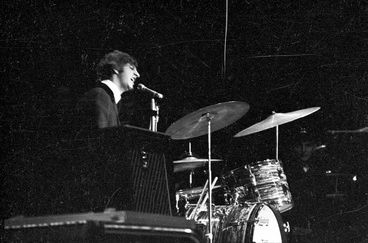
Ringo Starr on drums also sang "Boys"
Article includes a link to an audio interview with Ringo and a transcript
"I don't want to spoil the party ": Screams drowned out the music
Those who attended the concert found that the noise of the fans screaming drowned out the Beatles' singing. Only snatches of some words in a song could be heard, especially during the quieter song, "Till there was you".

"Misery" : Inadequate PA sound system
The Beatles complained that the PA sound system during their first concert was too low in volume. One of the supporting acts, Johnny Devlin contacted Philips Industries to arrange a replacement sound system which included several 100 watt amplifiers and a big Altec flare speaker. A couple of 15-inch speakers were placed by the organ at the back of the hall, and a couple of columns of speakers were positioned on each side of the stage. By way of thanks, the Beatles agreed to Devlin's request for a photo with them. (See story and photo in Audioculture, op cit .)
23 June: Two evening concerts held at the Wellington Town Hall
Fans demonstrating during Beatles' concert at Wellington Town Hall
For reminiscences about the Beatles in Wellington, see: RNZ: "The Beatles New Zealand Tour 1964 Part 2: The Beatles in Wellington, URL: https://www.rnz.co.nz/national/programmes/afternoons/audio/2600012/the-beatles-new-zealand-tour-1964-part-2
4. " Baby it's you ": Ringo Starr's & John Lennon's NZ family connections
Ringo Starr (born Richard Starkey) was visited in his hotel room by Starkey relatives who were living in the Wellington suburb of Karori. The three sisters, who were thought to be distant cousins of Ringo, were Christine (age 16), Patricia (age 13) and Theresa (age 12) Starkey, whose family moved from Liverpool in 1963. Ringo gave them his autograph and afterwards said, "It was nice meeting them, but I'm not quite sure where in the family they fit in." See article with photo: Meet the Beatles for real - " Ringo's mystery cousins " (24 June 2014)
John Lennon's Aunt Mimi (Mary) Smith who lived in Liverpool was visiting relatives in New Zealand. She stayed at her cousin Annie Parker's Koputaroa farm near Levin for a week prior to the Wellington concerts, and stayed on for months after the tour. Aunt Mimi and the Parker family visited John Lennon at the St George Hotel in Wellington and attended the concert later that evening.
John's second cousins (from left) Mark, Susan & Helen Parker, from Levin, & his Aunt Mimi who was visiting from England
Beatle John Lennon with second cousins from Levin
John Lennon with his second cousins (from left) Susan, Helen & Mark Parker, from Levin
John Lennon with his first cousin once removed, George Matthew, & Aunt Mimi visiting from England
Beatle John Lennon with his aunt Mimi Smith, and cousin George Matthew
See reminiscences by John Lennon's second cousin Mark Parker in an interview with Paul Williams (16 June 2020), " Imagine: John Lennon's cousin from New Zealand pressed for memories ", Horowhenua Chronicle.
John Lennon's second cousin Lynda Mathews reminisces in 2014 about their meeting fifty years ago
Lennon cousin remembers Beatles visit
5. " i'll follow the sun" : auckland concerts: 24-25 june.
Boarding plane at Wellington to fly to Auckland for concerts on 24 & 25 June
When the Beatles arrived at the Whenuapai Airport there were about 300 fans waiting
"misery ": fans jostle beatles outside hotel.
When the limousine carrying the Beatles from the Whenuapai Airport arrived at the Royal International Hotel, the 2000 waiting fans crowded the vehicle. Only three police had been assigned by the Auckland Police Station to manage the crowd and ensure the Beatles exited their vehicle safely.
John Lennon said later, “ It was a bit rough. I thought definitely a big clump of my hair had gone. I don’t mean just a bit. They’d put about three policemen on for 3000 or 4000 kids and they refused to put more on. ‘We’ve had all sorts over ’ere, we’ve seen them all,’ they said, and they had seen them all as we went crashing to the ground.” Angry, Lennon threatened he wouldn’t perform that night unless more police were on duty. "
Source: Audioculture: Chris Bourke, 'Beatles invade New Zealand, 1964": URL: https://www.audioculture.co.nz/articles/beatles-invade-new-zealand-1964
"P.S. I love you" : Housemaid kisses Beatle on hotel's balcony
An 18 year old applied to be a housemaid about a week before the Beatles arrived at the hotel. When the Beatles went out onto the balcony to wave to the fans, she used an adjacent room's fire escape to sneak out to join them. After kissing George, she was noticed by the security guards and was hustled back inside.
Source: Meet the Beatles for real: Blog post: Tuesday, June 24 2014 "Not the best welcome in Auckland". See Comment posted on April 2, 2021: http://www.meetthebeatlesforreal.com/2014/06/blog-post_24.html
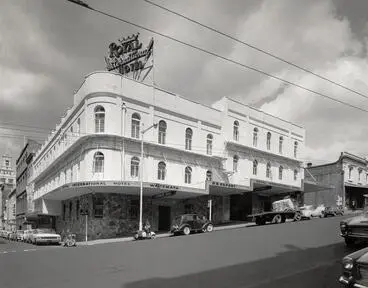
The Beatles stayed at the Royal International Hotel on corner of Victoria Street and Albert Street
When they arrived, 2000 fans were waiting outside
"Don't bother me" : Chief Superintendent refused to provide extra police for the Civic welcome at the Town Hall
The Auckland Chief Superintendent refused the request by Derek Taylor, the Beatles’ press officer, to provide additional police to escort the Beatles from their hotel to the Auckland Town Hall to attend the Mayor's civic welcome, saying “You are not royalty”. Mayor Dove-Meyer Robinson arranged with the city’s traffic commissioner to provide civilian patrol vehicles.
For reminiscences about the Beatles staying at the hotel and their Auckland shows, see:
Andy Neill (23 June 2014), '"The Beatles in Auckland bigger than royalty", Metro: URL: https://www.metromag.co.nz/arts/arts-music/the-beatles-in-auckland-bigger-than-royalty
Audioculture: Chris Bourke, "Beatles invade New Zealand, 1964": URL: https://www.audioculture.co.nz/articles/beatles-invade-new-zealand-1964
RNZ: The Beatles New Zealand Tour 1964 Part 3: The Beatles in Auckland, URL: https://www.rnz.co.nz/national/programmes/afternoons/audio/2600013/the-beatles-new-zealand-tour-1964-part-3
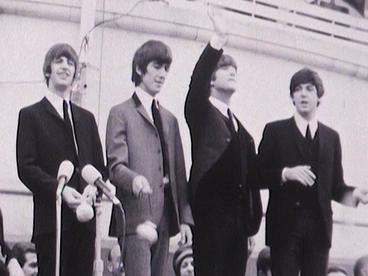
Beatles were greeted at a civic welcome by Sir Dove-Myer Robinson at the Town Hall in front of a large crowd of 7000
NZ On Screen film (Length 8:21)
NZ On Screen
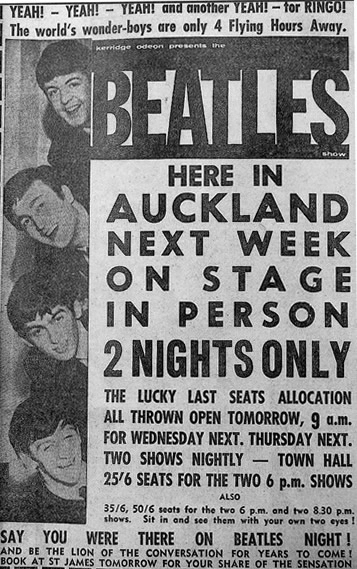
The Beatles played 2 nights in Auckland: 24 & 25 June
Two shows were held each evening
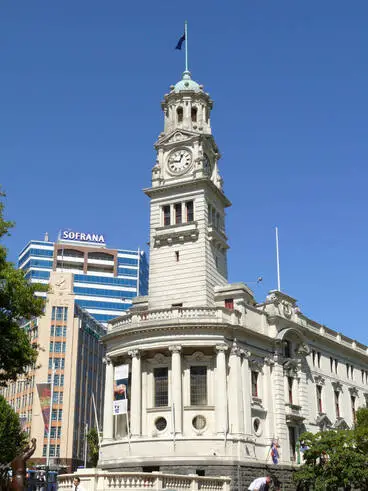
The concerts were held at the Auckland Town Hall
6. " not a second time ": dunedin concerts: 26 june.
Unlike the Wellington and Auckland concerts where four concerts were held over two evenings, two shows only were held in Dunedin which were on the same evening.
"If I fell": John Lennon thrown through Hotel's door
When the Beatles arrived at the City Hotel in Dunedin there were about two thousand fans waiting who crowded around the entranceway and on the verandah above.
" John Lennon was the last out of the car and by this time the police and security men had had enough. Dunedin broadcaster Neil Collins remembers the police picking up Lennon and throwing him through the front door. “I mean that. He was airborne when he reached that lift, and he was wearing leather pants and he cut his knee open on the iron of the lift.” Lennon stormed up to his room on the third floor, and refused to attend the press conference . " ( Source : Audioculture: op cit )
Archived photographs of the Dunedin concerts were published by the Otago Daily Times on 9 October 2021 in an article by Hamish MacLean, "The day the Beatles rocked staid Dunedin", URL: https://www.odt.co.nz/news/dunedin/day-beatles-rocked-staid-dunedin
For additional reminiscences about Dunedin, including a "germ bomb" hoax, see: Audioculture: Chris Bourke, 'Beatles invade New Zealand, 1964": URL: https://www.audioculture.co.nz/articles/beatles-invade-new-zealand-1964
Also see: RNZ: The Beatles New Zealand Tour 1964 Part 4: The Beatles in Dunedin, URL: https://www.rnz.co.nz/national/programmes/afternoons/audio/2600014/the-beatles-new-zealand-tour-1964-part-4
Two shows were held at the Dunedin Town Hall on 26 June
The Beatles stayed at the City Hotel. They were met outside by 2000 fans & John was bundled inside by police.
7. "I'm happy just to dance with you": Last two concerts held at Christchurch, 27 June
See reminiscences about the Beatles in Christchurch in the following:
Vicki Anderson, 'Fifty years since Beatles' Christchurch tour", Stuff (11 April 2014): URL: https://www.stuff.co.nz/the-press/christchurch-life/9929379/Fifty-years-since-Beatles-Christchurch-tour
Audioculture: Chris Bourke, 'Beatles invade New Zealand, 1964": URL: https://www.audioculture.co.nz/articles/beatles-invade-new-zealand-1964
RNZ: The Beatles New Zealand Tour 1964 Part 5: The Beatles in Christchurch, URL: https://www.rnz.co.nz/national/programmes/afternoons/audio/2600015/the-beatles-new-zealand-tour-1964-part-5
The Beatles stayed at the Clarendon Hotel in Christchurch
Amongst the 5000 crowd there were some who threw eggs and tomatoes when the band appeared on the hotel balcony
Archives New Zealand Te Rua Mahara o te Kāwanatanga
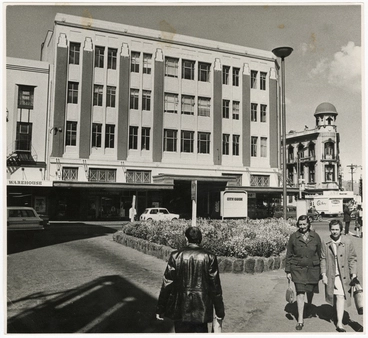
Two evening shows were held at the Majestic Theatre on 27 June
Christchurch City Libraries

Steven Bridges' memories of the Christchurch press conference
8. "when i get home" : beatles depart christchurch for australia: 28 june 1964.
The following interviews were held on the plane:
'George Harrison and Ringo Starr interview, 1964', URL: https://nzhistory.govt.nz/media/sound/george-harrison-and-ringo-starr-interview-1964 , (Ministry for Culture and Heritage), updated 8-Mar-2013
'Paul McCartney and John Lennon interview, 1964', URL: https://nzhistory.govt.nz/media/sound/paul-mccartney-and-john-lennon-interview-july-1964 , (Ministry for Culture and Heritage), updated 8-Mar-2013
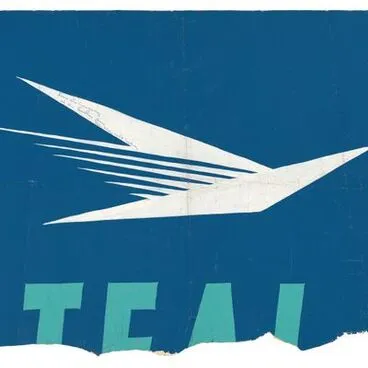
The Beatles left Christchurch aboard a TEAL plane for Australia on Saturday 28 June
Two thousand people watched the Beatles leave the Clarendon Hotel and another 2000 were waiting at the airport
9. "All my loving" : other reminiscences of NZ tour
For other reminiscence by Beatles' fans, musicians and broadcasters, see the list of audio clips compiled by RNZ: "The Beatles New Zealand Tour 1964", URL: https://www.rnz.co.nz/national/programmes/the-beatles-new-zealand
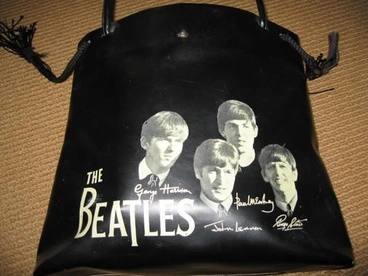
Beatles souvenir bag
10. "i'll be back" : three beatles re-visited nz, 1984 - 2017.
Three of the Beatles had individual visits to New Zealand between 1984 and 2017. (John Lennon died on 8 December 1980.)
George Harrison (Born 25 Feb 1943 – Died 29 Nov 2001)
1984: George attended the NZ book launch of the autobiography by former Beatle publicist Derek Taylor - "Fifty Years Adrift" - which George had edited. Publisher was Genesis Publications Limited in association with Hedley New Zealand and Hedley Australia. The book launch luncheon, followed by a press conference, was held at the Auckland Hyatt-Kingsgate Hotel on Wednesday 28 November.
Youtube : George Harrison & Derek Taylor - Fifty Years Adrift Auckland Press Conference - 28 November 1984: https://www.youtube.com/watch?v=q0r_nrWW6jU
Papers Past: Chris Knox, "A Beatle, a book, a ballroom:, Rip it Up Issue 89, 1 Dec 1984, pp. 12, 14
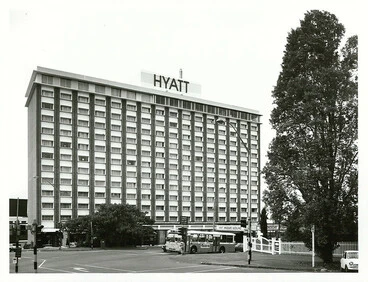
On Wed 28 Nov 1984, George Harrison attended a book launch at the Auckland Hyatt-Kingsgate Hotel
Derek Taylor's book "Fifty Years Adrift" published by Genesis Publications Limited in association with Hedley NZ
Paul McCartney (Born 1 June 1942 - )
1993: " The New World Tour " (which included Linda McCartney) at Western Springs, Auckland on Saturday 27 March 1993
2017: " One On One " tour at Mt. Smart Stadium, Auckland on Saturday 16 December

Paul McCartney held shows in Auckland on 27 March 1993 & 16 Dec 2017
Ringo starr (born 7 july 1940 - ).
2013: Ringo and his All-Starr Band performed at the CBS Arena, Christchurch on Thursday 7 Feb and at the Vector Arena, Auckland on Saturday 9 February. The Band comprised: Todd Rundgren, Steve Lukather (Toto guitarist), Richard Page (Mr Mister bassist), and Gregg Rolie (keyboardist & early singer of Santana and Journey).
Stuff: Matt Davey, " Ringo Starr kicks off tour in Chch " (12 Feb 2013)
NZ Herald: " Concert review: Ringo Star and His All Starr Band, Vector Arena " (11 Feb 2013)
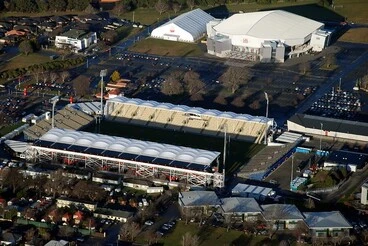
Beatles' meetings with extended family in Wellington during band's 1964 New Zealand tour
Martin johnston.
Share this article
Reminder, this is a Premium article and requires a subscription to read.
John Lennon with Kiwi relatives (from left) Sue, Helen and Mark Parker, of Levin, during the Beatles 1964 New Zealand tour. Photo / Alexander Turnbull LIbrary EP/1964/2089-F
Before John Lennon and the Beatles were superstars, he was described as a "naughty" boy in family letters to his relatives in faraway New Zealand.
Annie Parker of Levin corresponded with her cousin Mimi Smith in Liverpool, an aunt of Lennon, who raised him.
"She had this boy and he was in this band, and always doing naughty things," says Sue Snaddon, Parker's daughter.
"She was always telling him he had to get a proper education and a proper job, but that didn't happen."
That naughty boy then brought eight days of mayhem to New Zealand, 55 years ago this month, and met several of his Kiwi rellies who today still get excitement from sharing their memories of the global superstar and songwriting genius.
Smith used her nephew and his band's concert as an excuse to meet the New Zealand relatives.
Smith and Parker's mothers were sisters and the latter moved from the UK to New Zealand with her young family.
Smith spent several months in New Zealand, including staying for weeks at the Parkers' farm with Annie, her husband and children Sue, Helen and Mark.
Beatlemania had broken out in the UK in late 1962, when high-pressure hoses were used to control crowds before a concert.
The fan hysteria intensified through 1963 after the band's debut album, Please Please Me, was released in March that year.

New Zealand wasn't immune to music hysteria.
Johnny Devlin, "New Zealand's Elvis", had inspired girls to scream at his shows with his Presley-style grinding and wriggling, or leg-shaking as he called it.
A fire hose was even used to control hysterical fans in Greymouth. Devlin would play as a supporting act or the Beatles.
The Fab Four began their New Zealand tour in Wellington, landing at the airport to a screaming crowd of 7000 fans, mostly young women and girls, 30 police officers and a Māori concert party.

Lennon, Paul McCartney, George Harrison and Ringo Starr twisted and shouted and turned New Zealand upside down, playing in Auckland, Dunedin and Christchurch.
Snaddon remembers Smith staying with her family when she was 14 years old. She visited the Beatles at the Hotel St George, where they were staying, before one of their four concerts in Wellington, with Smith, her parents and siblings.

"We all sat around in one of their lounges and had afternoon tea and chatted; two photos were taken, then we went to the concert," she tells the Herald on Sunday.
She met only three Beatles — McCartney was "busy entertaining a lady".
"John wanted to give us stuff, he was very generous to all his extended family. He gave money to Mimi to take me to the jewellers and to get something to remember him by — bangles."

They are inscribed, "To Susan from John Lennon".
"I loved the Beatles growing up and still love their music," says Snaddon, now 69 and living on the Kapiti Coast.
But brother Mark wasn't inspired by the concert.
• Sir Peter Jackson to make new film about the Beatles' Let It Be • The White stuff: How The Beatles made their weirdest album • The killings in Auckland's Queen St that fuelled a moral panic
"I wasn't into music. I'm still not into music. It didn't do a great deal for me.
"I was 12 and a boy and liked sport. If you said to me go and meet the All Blacks or go and meet the Beatles, I would have said All Blacks. I wasn't that keen.
"I didn't speak to John, I don't think. I sat down on the floor and Ringo, who seemed quite an open sort of fellow, came and sat down beside me and I talked to Ringo for a while. I don't remember what he talked about. Mimi stayed at our farm. She was in my bedroom for at least a few weeks."
S mith also stayed at the family farm near Eketahuna of Parker's brother, who was a baby when their parents moved to New Zealand.

His daughter Lynda Mathews was 17 and became part of a Wairarapa journalistic plan that took her to their hotel rooms in Wellington.
"Because I was John's second cousin, the local newspaper was able to arrange a meeting with John and the other Beatles," she tells the Herald on Sunday. "I had to be taken through the crowd of girls abusing me and spitting at me — the police had to take me through. It was quite frightening because it was so crowded and tight."
"Hello love," was Lennon's greeting to her, she says, and he asked about her family and Smith.

In Graham Hutchins' book, Eight Days A Week: The Beatles' tour of New Zealand 1964, Mathews wrote: "Derek Taylor, the Beatles' publicity officer, identified the family likeness when he met me."
"I remember sitting on a bed in the Beatles' hotel room, sipping whisky and Coke," wrote Mathews, who now lives in Upper Hutt.
"I saw the first evening show and, after John had given me free tickets, part of the following afternoon's session."

Meanwhile Ringo Starr — whose given name is Richard Starkey — met his Starkey relatives of Karori.
Historian and journalist Redmer Yska told the Herald on Sunday he was at school with a Starkey girl, who had "quite a lot of mana" through her Beatles connection.
T he Beatles tour was a revolution: the moment young New Zealand plugged into global youth culture, says Yska.
The country was opening to the world as never before through television, then new, and the beginning of mass air travel overseas.
When the Beatles plane arrived in New Zealand on June 21, 1964, one girl's leg was cut as she tried to climb the fence, which was at risk of collapse. The fence was cut open and people were forced through it by people pushing from behind.
"We underestimated the whole thing badly," senior police officer Bill Brien recalled, according to an account written by Yska.
Te Pataka concert party performed a haka, giant tiki were presented and there was a hongi with the Beatles, eliciting quips from Ringo, "Hey fook. We come in peace," and from Lennon, "Me wife will kill me for this."

They toured the crowd in the back of a police ute and switched to cars for the drive to the city and the Hotel St George, where thousands of fans packed the streets.
To avoid the throng they were sneaked into the hotel through a bottle shop and taken to the third-floor balcony to greet fans.

"The balcony appearance by the group turned the crowd into a screaming frenzy," the Press Association reported at the time.
The shows typically consisted of 10 or 11 songs, including I Want to Hold Your Hand, All My Loving and Twist and Shout. The shortest show of the tour, at 26 minutes, was in Christchurch.
At the Wellington Town Hall, the audience's screaming was said to have been louder than the music.
Devlin complained about the sound system and Lennon joined in, reportedly shouting backstage: "What the f***ing hell is going on?"
McCartney too was unhappy: "We have sung through worse mics, but not very often; usually during the early days. We expected better here."

The band were trampled and mauled as they tried to get to their hotel in Auckland and Lennon later said the lack of security nearly led to the city's shows being cancelled.
Starr, after being slightly injured, was said to have refused to play more shows until assured of a sufficient police presence.
Lennon later said: "It got a bit rough in New Zealand. A big clump of my hair had gone and I don't mean just a bit. I was halfway on the ground. They put three or four police on for three or four thousand kids and refused to put any more on."
In Christchurch they were pelted with tomatoes and eggs on their Clarendon Hotel balcony, and with marbles and jelly beans in their show. Among the massive crowds out to see their arrival in the city, a 13-year-old girl threw herself at the bonnet of the car. She bounced off uninjured.
A crowd of 2000 was at the city's airport when they left, bound for Australia.
T here was a wave of youth culture in the 1950s, says Yska, author of the book All Shook Up: The flash bodgie and the rise of the New Zealand teenager in the Fifties.
These pressures had been partly held back by the Government-commissioned Oswald Mazengarb report into juvenile delinquency and the related moral panic over teenage sex.
There was a current of mainstream conservative adult dislike of the Beatles because the Liverpool quartet were considered rough and tough and working class and "they had lots of rings and long hair".
"It was like they were from another planet," says Yska.

Former Auckland City Council member and Auckland Rugby president Tom Pearce, father of Waitākere Ranges Local Board member Sandra Coney, objected to Mayor Dove-Myer Robinson's holding a civic reception for the band.
"If we are going to pander to the hysteria, antics, adulation, rioting, screaming and roaring, and all the things these bewigged musicians engender, I think we should make a point of honouring any youths with a sporting background who are at least endeavouring to act in the best traditions of the young men of this nation."
Council colleague Sir Keith Park, a World War I fighter ace and a World War II Royal Air Force chief, wanted future civic receptions restricted to "very important people". "I have nothing to say against the Beatles," he asserted at the time. "They give an immense amount of pleasure and fun to thousands of young people. It is not up to us older ones to deny them this childish entertainment."
Yska said the police attitude to the Beatles appeared to be: "We didn't want them here and we can't be bothered with them … so they didn't look after them."

Snaddon and Mathews never met Lennon again, but cherish the memory of meeting him and his band. Snaddon stayed in touch with Smith and says she was sent Lennon's book.
After he was shot and killed in the archway of his Manhattan apartment building in 1980, Mathews says she was devastated. "It was unbelievable. It was just awful."
Lennon had sent her a telegram after she became engaged, and sent another to her wedding.
"I still have some excitement," says Mathews. "It's unbelievable. To think I'm actually related to him is a bit remarkable."

Latest from Entertainment

OJ Simpson: Made in America, made by TV
NY Times: In OJ Simpson’s life and trials, TV was a spotlight, a microscope and a mirror.

Splore Festival taking a break in 2025 after 'challenging' year

Spy: Red White and Brass to hit the stage with star John-Paul Foliaki

O.J. Simpson: Kiwi expert witness Bruce Weir looks back on the famous trial

How smart charging saves money, power

- Kindle Store
- Kindle eBooks
Promotions apply when you purchase
These promotions will be applied to this item:
Some promotions may be combined; others are not eligible to be combined with other offers. For details, please see the Terms & Conditions associated with these promotions.
Buy for others
Buying and sending ebooks to others.
- Select quantity
- Buy and send eBooks
- Recipients can read on any device
These ebooks can only be redeemed by recipients in the US. Redemption links and eBooks cannot be resold.

Download the free Kindle app and start reading Kindle books instantly on your smartphone, tablet, or computer - no Kindle device required .
Read instantly on your browser with Kindle for Web.
Using your mobile phone camera - scan the code below and download the Kindle app.

Image Unavailable

- To view this video download Flash Player
Follow the author

Eight Days A Week: The Beatles’ Tour of New Zealand 1964 Kindle Edition
- Print length 306 pages
- Language English
- Sticky notes On Kindle Scribe
- Publication date June 13, 2014
- File size 3456 KB
- Page Flip Enabled
- Word Wise Enabled
- Enhanced typesetting Enabled
- See all details
Editorial Reviews
About the author, product details.
- ASIN : B00KZ9E25A
- Publisher : Exisle Publishing (June 13, 2014)
- Publication date : June 13, 2014
- Language : English
- File size : 3456 KB
- Text-to-Speech : Enabled
- Screen Reader : Supported
- Enhanced typesetting : Enabled
- X-Ray : Not Enabled
- Word Wise : Enabled
- Sticky notes : On Kindle Scribe
- Print length : 306 pages
- Page numbers source ISBN : 1459679792
About the author
Graham hutchins.
Discover more of the author’s books, see similar authors, read author blogs and more
Customer reviews
Customer Reviews, including Product Star Ratings help customers to learn more about the product and decide whether it is the right product for them.
To calculate the overall star rating and percentage breakdown by star, we don’t use a simple average. Instead, our system considers things like how recent a review is and if the reviewer bought the item on Amazon. It also analyzed reviews to verify trustworthiness.
- Sort reviews by Top reviews Most recent Top reviews
Top review from the United States
There was a problem filtering reviews right now. please try again later..
- Amazon Newsletter
- About Amazon
- Accessibility
- Sustainability
- Press Center
- Investor Relations
- Amazon Devices
- Amazon Science
- Start Selling with Amazon
- Sell apps on Amazon
- Supply to Amazon
- Protect & Build Your Brand
- Become an Affiliate
- Become a Delivery Driver
- Start a Package Delivery Business
- Advertise Your Products
- Self-Publish with Us
- Host an Amazon Hub
- › See More Ways to Make Money
- Amazon Visa
- Amazon Store Card
- Amazon Secured Card
- Amazon Business Card
- Shop with Points
- Credit Card Marketplace
- Reload Your Balance
- Amazon Currency Converter
- Your Account
- Your Orders
- Shipping Rates & Policies
- Amazon Prime
- Returns & Replacements
- Manage Your Content and Devices
- Recalls and Product Safety Alerts
- Conditions of Use
- Privacy Notice
- Consumer Health Data Privacy Disclosure
- Your Ads Privacy Choices
Navigation for The Beatles New Zealand Tour 1964
About the beatles new zealand tour 1964.
- International edition
- Australia edition
- Europe edition
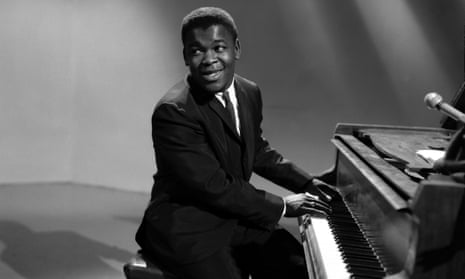
Clarence ‘Frogman’ Henry obituary
New Orleans singer whose 1950s and 60s hits included Ain’t Got No Home and (I Don’t Know Why) But I Do
Among the seemingly endless parade of American singers with exotic names and distinctive voices who populated the early years of rock’n’roll, from Fats Domino with his bluesy croon on Blue Monday to Buddy Holly and his ardent hiccupping on Peggy Sue , few were more easily identifiable than Clarence “Frogman” Henry, whose nickname referred to a vocal trick he had developed in his schooldays in New Orleans. Henry, who has died aged 87, had only three big hits, but they were not easily forgotten.
The first, Ain’t Got No Home , was released in 1957 and immediately established his claim to uniqueness. Having sung the first two verses in his normal genial tenor register, he switched to a squeaky falsetto, impersonating a girl, before giving his impression of a croaking bullfrog singing the same tune. It was gimmicky, but gimmicks went a long way in the era of Purple People Eater and Monster Mash , and the song made it into the US Top 20.
It was four years before he reached the charts again, this time with (I Don’t Know Why) But I Do , a plaintive ballad propelled into the Top Five on a gently shuffling New Orleans rhythm. Later, in 1961, You Always Hurt the One You Love made it to No 12.
Those successes, and his performances in the UK in 1962 on a package tour with Bobby Vee , Tony Orlando and the Springfields, brought him an invitation to tour the US and Canada with the Beatles in 1964, making him an astonished witness to the first wave of Beatlemania in North America.
He was born to Ernestine Henry and her husband, Clarence Sr, a railroad porter and amateur musician, in New Orleans’s 7th Ward before the family moved to the Algiers neighborhood, across the river from the French Quarter. Clarence Jr took piano lessons from the age of eight and was soon, in the local tradition, playing the trombone in his high school band. His piano heroes were Domino and Professor Longhair (Roy Byrd), the local keyboard giants, and soon he was playing in local bands. After he had formed his own trio, his destiny was shaped by an encounter with Paul Gayten, a bandleader who had become the local talent scout for Chicago’s Chess label, the home of Chuck Berry and Bo Diddley .
While sharing the bill with Gayten’s band at the Joy Lounge, Henry performed a song he had begun working on, as he later remembered, while trying to persuade patrons to leave a club at six o’clock in the morning. “Ain’t got no home,” he sang, in three successive voices, changing the words to match: “I’m a lonely boy/girl/frog.” The frog sound, which he had developed while teasing girls in the schoolyard, came from breathing in and singing at the same time.
He recorded the song under Gayten’s supervision, but it first appeared as the B-side to a song called Troubles, Troubles . When Clarence Hayman, a New Orleans disc jockey known as Poppa Stoppa, took a liking to the B-side and began playing it on the radio, the response from listeners calling in to request “the song by the frog man” persuaded the record company to begin promoting Ain’t Got No Home around the country. As it climbed the charts, Henry happily adopted his new sobriquet.
After a fallow couple of years, But I Do came along to revive his fortunes. Written by the Louisiana songwriter Bobby Charles in collaboration with Gayten, it was followed into the charts by Henry’s version of You Always Hurt the One You Love, an old Mills Brothers song. The absence of further frog impersonations did nothing to hinder their chart success.

Returning from the Beatles tour, Henry settled into a routine of playing with his band at clubs along Bourbon Street. He became a fixture at the annual New Orleans Jazz and Heritage festival, latterly singing from a wheelchair, and had been booked to appear again in the month of his death.
Although he continued to record for other labels, including an album made during a stay in the UK in 1983, there would be no more hits. But his income received a boost when Ain’t Got No Home appeared on the soundtracks of several films, including Forrest Gump and Casino. And when the rightwing radio personality Rush Limbaugh used it to mock homeless people, he was not going to decline the extra royalties.
“We do a variety of music,” he told John Broven, the author of Walking to New Orleans (1974), a decade after his heyday. “We don’t cater to one style of songs. We do Dixieland, pop, the classics, you know. We don’t do opera, though. The only thing we do is soap opera.”
Each of his seven marriages (two of them to the same wife) ended in divorce. He is survived by 10 children and 19 grandchildren.
- Pop and rock
Comments (…)
Most viewed.

IMAGES
VIDEO
COMMENTS
The Beatles New Zealand tour, 1964. 21 June The Beatles arrive. 22 and 23 June Wellington concerts * 24 and 25 June Auckland concerts * 26 June Dunedin concert * 27 June Christchurch concert 28 June The Beatles leave. *Played two shows per day, 6 p.m. and 8.30 p.m.
The Beatles Down Under: the 1964 Australia & New Zealand tour. Glebe, NSW Australia: Wild & Woolley. Baker, Glenn A (1985). The Beatles Down Under: the 1964 Australia & New Zealand tour (2 ed.). Ann Arbour, Michigan, USA: Pierian Press. ISBN -87650-186-2. Hutchins, Graham (2004). Eight Days a Week:the Beatles' tour of New Zealand 1964 ...
The Beatles had travelled to Auckland from Australia on 21 June 1964, but didn't perform in the city until 24 June. As on other days during the New Zealand leg of their world tour, The Beatles encountered unwillingness from local police to provide adequate protection. Auckland's Inspector of Police told the group's management: "We didn ...
Chris Bourke. 19 Jun 2014. Wellington greets The Beatles. In 1964, on a sunny Sunday afternoon in mid-winter, 7000 Wellingtonians made their way to Rongotai airport to greet four Liverpudlian musicians who combed their hair forward. The Beatles' eight-day visit to New Zealand has been well covered in the 50 years since they first touched ...
The Beatles live: Town Hall, Dunedin, New Zealand. The Beatles' flight from Auckland to Dunedin on 26 June 1964 was marred by a bomb scare before take-off. An anonymous tip-off suggested a 'germ bomb' had been placed on board the aeroplane, causing an anxious flight for the passengers. Fortunately there were no problems, and their ...
The Beatles New Zealand Tour 1964 Part 2: Wellington. history music. 24 Jun 2014. The Beatles play their first four concerts in Wellington. Screaming overpowers the local sound system while hotel security is breached by a group of female fans. The group play the same set of songs…. Read more Audio.
21 June 1964. Beatlemania hit New Zealand when 7000 hysterical fans greeted the Fab Four in Wellington during their 'Far East' tour. After concerts in the United States, Europe, Hong Kong and Australia, the lads from Liverpool touched down in New Zealand. The Beatles' fame preceded them and our teenagers were ready for action.
The Beatles gave just four nights of concerts in New Zealand, starting on 22 June 1964. The trip was largely seen as less successful than previous stops on their world tour, mainly due to sound problems and police attitudes. They performed at the Town Hall on Wellington's Cuba Street. As on the following night, there were two shows, each of ...
The South Island was the last leg of The Beatles' whistle-stop tour of New Zealand in 1964. The concerts in Dunedin on 26 June were some of the wildest of the New Zealand tour. Police were out in force. Fans used police helmets as footballs, kicking them up and down the aisles. Beatlemania also gripped the normally staid city of Christchurch.
The year is 1964, and at the peak of their fame, the Beatles visited New Zealand, where they were met with an all-too-familiar phenomenon — Beatlemania. The iconic British boyband washed up on our shores to waves of screaming, adoring fans. No one could anticipate the chaos the 'fab four' would bring to Aotearoa's streets as fans flocked ...
In 1964 the Beatles toured New Zealand. They had to contend with thousands of unruly, screaming fans, disorganised security and poor sound but for many New Zealand teenagers it was the event of a lifetime. The fact they couldn't hear the music for the screaming didn't stop fans enjoying themselves. The tour inspired many New Zealanders to form ...
A series of photographs taken in June 1964 by Morrie Hill and Evening Post Staff photographers. From the Alexander Turnbull Library, used with permisson. Ringo Starr being greeted with a hongi in Wellington by Morrie Hill. Alexander Turnbull Library. Crowd at Wellington Airport awaiting the arrival of The Beatles by Morrie Hill.
The Beatles arrive in Wellington on 21 June 1964. 7000 fans turn up at the airport. Ringo names his gift Tiki "Fred". ... This five-part series recalls the times, the people and the music when The Beatles came to New Zealand. The Beatles New Zealand Tour 1964 is presented by Wayne Mowat, produced by Trevor Reekie and engineered by Jeremy Ansell ...
Beatles programme from 1964. The Beatles' 1964 tour occurred as New Zealand was undergoing a cultural shift. The values of younger New Zealanders seemed to be changing as one era passed and another emerged. From this time, New Zealand opened up to the world as never before through television and the beginning of mass air travel overseas.
On Sunday 21 June 1964, the Beatles arrived in Wellington for an eight-day tour. John, George, Paul & Ringo were greeted with a Māori pōwhiri by six women from the local Te Pataka Concert Party. The Beatles and an unidentified Maori group at Wellington Airport during their New Zealand tour. Alexander Turnbull Library.
The Beatles in Christchurch. The Beatles play their final two concerts in Christchurch, and call New Zealand audience "tame" despite having eggs, jellybeans and marbles thrown at them. The following day, 28 June 1964, 2000 fans see The Beatles depart Christchurch for the Australian leg of their tour. They leave behind ringing ears, grumpy police, damaged venues, a generation of teenagers ...
The outbreak of Beatlemania in Australia and New Zealand in June, 1964 was, arguably, without equal anywhere in the World in terms of the sheer magnitude and...
For a memorable week in June 1964, the Beatles toured New Zealand, giving concerts in the four main centres and changing life as we knew it for ever. For teenagers of the time, it was the most exciting week of their lives. Teachers were ignored and parents defied as thousands of young people devised ingenious ways of seeing their idols. For this book Graham Hutchins has interviewed dozens of ...
The Beatles were welcomed by a Māori concert party on their 1964 New Zealand tour. Lennon, Paul McCartney, George Harrison and Ringo Starr twisted and shouted and turned New Zealand upside down ...
The Beatles' first stop in New Zealand was Wellington. Seven thousand screaming fans - nearly all young women - waited as the band touched down on 21 June 1964. One girl badly slashed her thigh trying to climb a wire fence, and two others were forced through the fence because of pushing from behind. A team of 30 police officers, some in ...
For a memorable week in June 1964, the Beatles toured New Zealand, giving concerts in the four main centres and changing life as we knew it for ever. For teenagers of the time, it was the most exciting week of their lives. Teachers were ignored and parents defied as thousands of young people devised ingenious ways of seeing their idols.
Te Ao Māori. IndoNZ. Launch player. Audio help Launch player. The Beatles New Zealand Tour 1964. Search. Galleries.
Clarence 'Frogman' Henry obituary. New Orleans singer whose 1950s and 60s hits included Ain't Got No Home and (I Don't Know Why) But I Do. Richard Williams. Wed 10 Apr 2024 10.57 EDT. Last ...
Some New Zealanders must have wondered what had hit the country when the Beatles arrived at Wellington airport in June 1964. Hysterical fans greeted the 'Fab Four' wherever they went. In Auckland the decision by the mayor, Dove-Myer Robinson, to hold a civic reception for them led one of his councillors to complain about encouragement of the 'hysteria, antics, adulation, rioting ...